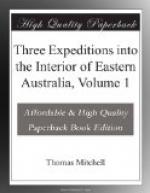THE BOATS.
The two boats mounted on the carriage were still in a perfect state; and although we had not derived much advantage from them, still in no situation had they appeared a superfluous portion of our equipment. Possessing these we crossed the low soft plains and dry lagoons of the Darling without any apprehension of being entirely cut off by floods, while we were always prepared to take advantage of navigable waters had we found any of that description.
PLAN OF ENCAMPMENT.
The carriage with the boats, mounted on high and covered with tarpaulin, when placed beside the carts according to our plan of encampment, formed a sort of field-work in which we were always ready for defence. We adhered to this which had been arranged not less with a view to general convenience than for defensive purposes. The carts were drawn up in one line with the wheels close to each other (see the woodcut); and parallel to it stood the boat carriage, room being left between them for a line of men. We had thus at all times a secure defence against spears and boomerangs in case of any general attack. The light waggons and tents were so disposed as to cover the flanks of our car-borne citadel, keeping in mind other objects also, as shown on the plan.
The two light carts (9) covered one flank, the men’s tents (5, 5) the other. These light carts carried the instruments, canteens, trunks, and articles in daily use. The situations of the different fires were regulated also, and only allowed to be made in the places fixed for each. The door of my tent (2) was usually towards the meridian (1) and in observing stars it was desirable that no such light should shine before the sextant glasses, nor any smoke impede the observations. By the accompanying plan it will be seen that no light was in the way, while, by these positions, other purposes were also answered. The cook’s fire (11) was near the light carts. Mr. Larmer’s fire and tent-door (3) were placed so as to be in sight of the cook. The men’s fire was made opposite to the two tents (5, 5) so as to serve for the men of both. The other fire of the men (5) completed a general arrangement of firelight around the boats and carts, so that nothing could approach by night unseen by the people at their fires. One of the heavy carts (7) was sufficient for the carriage of all articles in daily use: it was called the shifting cart, being the only one in the line which required to be loaded and unloaded at each camp; the rest contained gunpowder (6) and stores which were issued in rations every Saturday. One great convenience in having such a fixed plan of encampment was that I could choose a place free from trees and establish the whole party on the ground by merely pointing out the position for my own tent (2) and how it was to face (1).
No further orders were necessary and I could thus at once mount my horse and proceed to any distant height with the certainty of finding the whole camp established as I intended on my return. In arriving late at night on any spot and the party having to encamp in the dark, still everyone knew where to go, for by constant custom the arrangement was easily preserved. Thus anything we wanted could be found by night or day with equal facility; and we might be said in fact to have lived always in the same camp, although our ground was changed at every halt.




